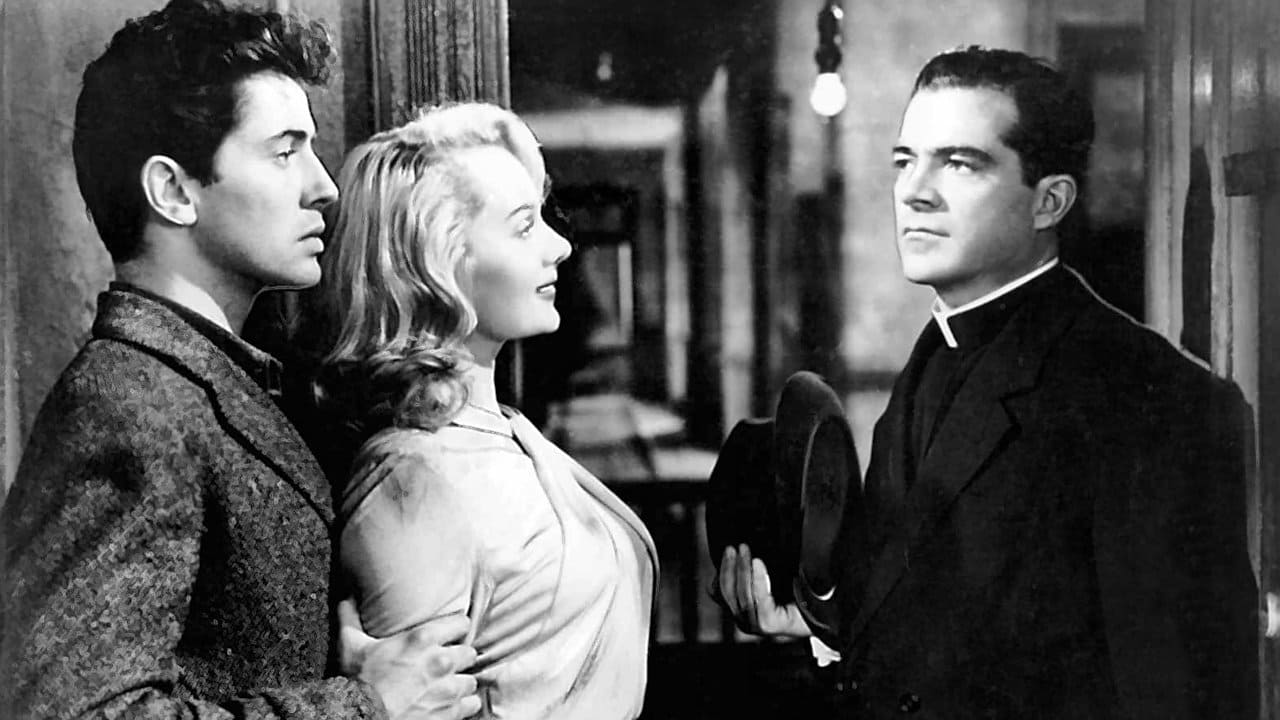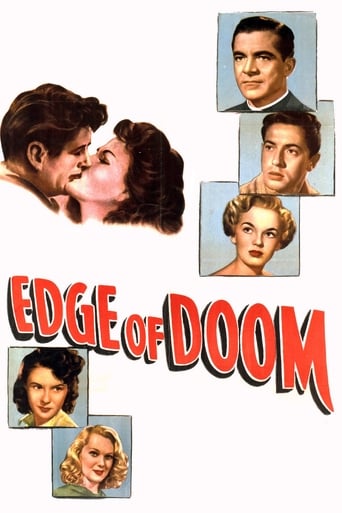

Am i the only one who thinks........Average?
... View MoreIt's funny, it's tense, it features two great performances from two actors and the director expertly creates a web of odd tension where you actually don't know what is happening for the majority of the run time.
... View MoreWhile it is a pity that the story wasn't told with more visual finesse, this is trivial compared to our real-world problems. It takes a good movie to put that into perspective.
... View MoreThis is a dark and sometimes deeply uncomfortable drama
... View MoreDana Andrews (Father Roth), Farley Granger (Martin Lynn), Joan Evans (Rita Conroy), Robert Keith (Mandel), Paul Stewart (Craig), Mala Powers (Julie), Adele Jergens (Irene), Harold Vermilyea (Father Kirkman), John Ridgely (1st detective), Douglas Fowley (2nd detective), Mabel Paige (Mrs Pearson), Howland Chamberlain (Mr Murray), Houseley Stevenson, Sr (Mr Swanson), Jean Innes (Mrs Lally), Ellen Corby (Mrs Moore), Ray Teal (Ned Moore), Mary Field (Mary Jane Glennon), Virginia Brissac (Mrs Dennis), Frances Morris (Mrs Lynn).Directed by MARK ROBSON. Screenplay: Philip Yordan. Based on the novel by Leo Brady. Music director: Emil Newman. Score: Hugo Friedhofer. Photographer: Harry Stradling. Editor: Daniel Mandell. Art director: Richard Day. Costumes: Mary Wills. Set decorator: Julia Heron. Make- up: Blagoe Stephanoff. Hair styles: Marie Clark. Additional scenes directed by Charles Vidor, written by Ben Hecht. Sound recording: Fred Lau. Producer: Samuel Goldwyn.Copyright 3 August 1950 by Samuel Goldwyn Productions, Inc. Released by RKO Radio Pictures. New York opening at the Astor: 3 August 1950. U.S. release: 30 September 1950. U.K. release: December 1951. Australian release: 16 August 1951. 99 minutes.U.K. release title: STRONGER THAN FEAR.SYNOPSIS: "It's simple story about a boy who wants a fine funeral for his mother, so he kills a priest." — Sam Goldwyn, explaining the plot to an eager group of journalists.NOTES: After its New York opening, Goldwyn rejigged the movie by adding narration, plus a prologue and epilogue, written by Charles Brackett and Ben Hecht, directed by Charles Vidor. Even with the additional scenes, the movie still came in at 96 minutes — 3 minutes less than before. Considerable excisions were made. Some of the most powerful episodes were deleted altogether, whilst others, notably the undertaker's sequence, were unmercifully diluted.VIEWERS GUIDE: Adults.COMMENT: This film is not now available in its original form but, whether called "Edge of Doom" or "Stronger Than Fear" (its U.K. release title), in a version somewhat mutilated by the addition of a fatuous prologue and epilogue and a patronizing commentary, all written by Ben Hecht and flatly directed by Charles Vidor.In its present state, the movie's entertainment quotient hasn't been increased, but lessened. Nonetheless, there are still features of interest to the connoisseur. The scene in which Harold Vermilyea is murdered still comes across with considerable force. The driving pace of Robson's direction, the moody black-and-white photography of Harry Stradling, the fine sets of art director Richard Day and some very good performances, particularly Vermilyea, Keith and Stewart, plus incisive dialogue are all positive recommendations.Offsetting all these is the glum performance of Dana Andrews, whilst Farley Granger makes an unlikely hero. Mala Powers is also very weak as the hero's girlfriend. And then there's that commentary!OTHER VIEWS: Whatever induced that normally astute showman Sam Goldwyn to attempt a film of Leo Brady's morbid novel? (Some sources say it was his wife, a convert to Catholicism). Whatever, Sam parted up with no less than $150,000 just for the film rights. He then ripped the guts out of the book by casting Dana Andrews as the priest. What few virtues Mr Andrews has as an actor — doggedness, certainly — neither sincerity nor saintliness, let alone spiritual strength, figure in that short list. Not that Farley Granger was any more charismatic, but at least his weakness was right for the role. As for the movie itself, even the re-edited light version is still mighty heavy going. — JHR writing as George Addison.
... View MoreConsidered one of the most Bleak, Depressing, Gloomy, Brooding, but Ultimately Unsuccessful in the Genre of Film-Noir. Unsuccessful at the Box Office and Unsuccessful, but Not Completely with Critics and Fans.It's a Troubled Subject and it was a Troubled Production. The Subject of "Religion" in Motion Pictures in the "Code" Era was Scrutinized as much as Anything from the "Overseers/Big Brother" Censors with Hays Hubris and Nothing Slipped by that wasn't "Christian" Friendly.So this Story of a Young Man who was Dissed by the Church and wouldn't give His Father a "Decent" Burial because of Suicide and the Trauma that Followed was Suspect. But that's just the Pro-Log. His Mother than Succumbs to TB, Dies, and the Trauma is Repeated. Not because of Suicide but because He and His Mother are Ghetto Dwelling Poor.What Ensues is a Film that had to be Pulled and "Softened" with "Book-Ending" New Scenes.The Movie is as Dark as Noir can get with its Relentless Display of an Uncaring and Ugly World, especially if You don't have Money. Audiences at the Time would have none of it and the "Money-Men" at the Studios Shunned the mere Existence of the Film and it Languished in Limbo for Years.The Star, Farley Granger Bad Mouthed the Movie any chance He got and the Film Remained Unrecognized for Decades. Dana Andrews, Paul Stewart and the rest of the Fine Cast all Add to the Agonizing Atmosphere and the Movie Stands on its own. Noble, but Flawed by Fawning Concerns that were Against the Grain of the Source Material.When Viewed Today, it can Showcase Societal Attitudes about Organized Religion, Pulverizing Poverty, and a Studio System, like American Lower Class Life, that was in Dire Need of Liberal Reform in a Post War America that was Showing its Capitalistic Muscle.
... View MoreFarley Granger is a young man on the "Edge of Doom," in this 1950 film also starring Dana Andrews, Mala Powers and Paul Stewart. When a young priest wants to change parishes, Father Roth (Dana Andrews) tells the story of Martin Lynn (Granger), saying that what happened with Martin showed him that, as a priest, he was in the right place. Martin Lynn is a young man who is having trouble making ends meet as a delivery man for a florist; he has a chronically ill mother, and he wants to be able to move her to Arizona. However, after working with the florist for four years, he still can't get a raise. When his mother dies, he wants a high-priced funeral for her. He goes to the church rectory, as his mother was deeply religious and, despite living in near poverty, always gave what she could to the parish church. In an ensuing argument with an old, tired and tough priest (Harold Vermilyea), Martin hits him over the head, and the priest dies. Later, he's picked up, not for the murder, but for the robbery of a movie theater actually done by his neighbor (Paul Stewart). Though released, the detective in charge (Robert Keith) is still suspicious of him."Edge of Doom" is a grim noir that never lets up; Martin Lynn can't get a break, not from his boss, the funeral director or the church. His girlfriend (Mala Powers) at first feels there is no place for her in his life because of his mother. After the mother dies and Paul commits murder, he breaks up with her. His only support is Father Roth, whom he doesn't like - he resents the church for not burying his father on hallowed ground when he committed suicide and for taking his mother's money. It's not often in a film that one sees a priest killed - and with a cross yet.The acting is good if not great. Farley Granger is sympathetic as Martin. He was often cast in this type of role. Dana Andrews does an okay job as the priest, but is a little too precious. The way to play a priest is the way Spencer Tracy did - as a man first. Andrews tries to put on a priestly air but it seems forced.Apparently this film was not well received upon release and was withdrawn to add the very beginning, where Andrews begins to tell the story, and the very end, which comes back to the present time with Andrews and the priest. It doesn't really help the film's relentless, depressing tone. Don't watch this one if you need a smile or a feel-good movie.
... View MoreMy view is that this movie falls somewhere between hose two genres. I'd call it closer to soap opera. And how, with all the talent involved, it failed so badly, makes it something of a mystery as well.The same year, "Side Street" came out. Farley Granger was heartbreaking. He had been heartbreaking in the most poetic of all noirs two years earlier, too: "They Live By Night." Here he shows, and elicits, no emotion at all. His character is written as someone who's a little slow. But why? There were lots of young men living with, and fanatically attached to their mothers. There still are some.)(By the way, I read the entry by the person whose father wrote the original book and feel empathy. There is certainly potential here. The movie just seems to have lost its way -- and lost it very early, despite the ministrations of a fine director, Mark Robson, and a superb screenwriter, in Philip Yordan.) None of it rings true, to put it bluntly. None of the major parts, that is. The florist for whom Granger works is well played and convincing. But the major characters are not credible.) Dana Andrews is miscast or ill directed as the understanding young priest who tries to help Granger. He goes in for such seriousness he seems to be speaking his every word in a hushed sounds. His delivery reminds me of Anne Baxter's when she is trying to convince people of her sincerity in "All About Eve." She convinced them for a while but he doesn't convince me. None of the principals do. And what a shame, too: It has potential and is performed, written, and directed by major talents.None is at his best here.
... View More